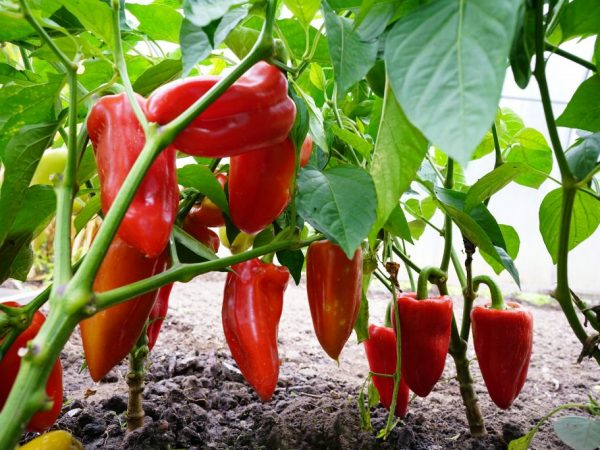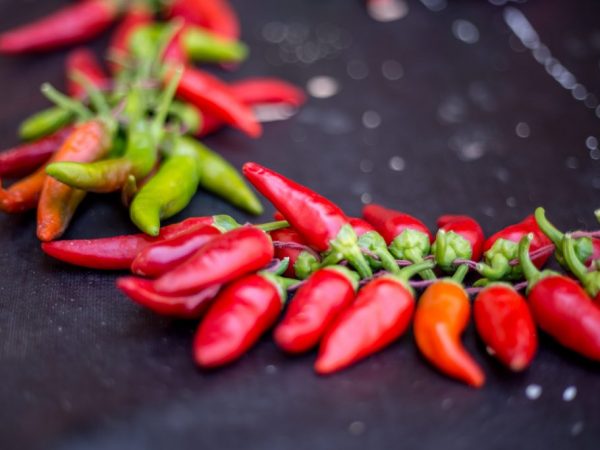Characteristics of Gypsy pepper
Among many Dutch varieties, Gypsy pepper is very popular. It is distinguished by a super-early type of ripening, unpretentiousness to conditions and ease of care. Resistant to weather changes and suitable for growing everywhere in the middle climatic zone.

Gypsy pepper
Variety characteristics
The Gypsy pepper variety belongs to the ultra-early, the first fruits reach biological maturation in 55-65 days from the moment the seedlings are planted. To get an early harvest in the greenhouse, seeds are sown at the beginning of February and the pick is not carried out.
It has a stable yield, from one bush you can collect 2-2.5 kg of pepper per season. The variety is suitable for growing in greenhouses and outdoors. It has a universal table purpose, suitable for fresh consumption, cooking and canning.
Description of the bush
The bush of this variety is low, reaches a height of 50-60 cm, medium branched. The stems are fragile and prone to mechanical damage. The superficial root system is in the ground no deeper than 25-30 cm. The leaves are medium-sized, wide, deep green in color. The shape of the leaf plate is elongated, the surface is smooth.
The bush blooms 60-70 days after sowing. The flowers are small, white, male and female. Flowering is long, does not stop until frost. Peppers are naturally self-pollinating plants, but cross-pollination is possible. It is often cross-pollinated with hot pepper, so it is better to plant such species in different beds at a distance of at least 10 m from each other.
Description of the fetus
The fruits of the Gypsy variety are not large-fruited, but have a beautiful, even shape and uniform size of the entire crop. The average weight is 100-120 g, it is 10-12 cm long and 5-6 cm wide.
Characteristic differences of the fetus:
- the skin is thin, dense with a waxy sheen;
- conical shape, evenly tapered towards the tip;
- wall thickness 4-6 cm;
- the pulp is crispy, homogeneous;
- divided into three chambers;
- seeds are light yellow;
- sweet taste, contain 7.5% sugar.
Peppers are considered technically mature when they turn a creamy yellow color, and when fully ripe, the fruit is deep red in color. Gypsy pepper seeds have a good germination rate of 75-80%.
Care
Sweet pepper Gypsy f1, according to the description, is undemanding to care, but proper agricultural technology will allow you to get well-developed bushes, high yields and even fruits of the correct shape. Peppers need regular, moderate watering, loosening the soil, weeding, fertilizing, and a garter.
Watering and loosening
The first watering is carried out at the time of planting seedlings. Planting holes are spilled with water, and when moisture has been absorbed, young plants are planted. After 3-5 days, watering is repeated.
Throughout the season, the bushes are watered according to the scheme 1 time per week until the moment of mass fruiting. When the first batch of fruits has begun, watering is stopped. Renewed after harvest at the beginning of re-flowering.
Among the basic rules for high-quality irrigation, it is necessary to highlight:
- Water for irrigation should be settled and warm (above 22 ° C).
- Watering is carried out in the morning or evening.
- Water the bushes under the root carefully so as not to erode the soil.
- For watering one bush, 2-2.5 liters of water is enough.
Loosening of the soil has a beneficial effect on growth. This will help to saturate the earth with oxygen, which improves gas exchange processes and increases the supply of nutrients.
Loosening is carried out after watering. And also after the rain. The loosening depth depends on the stage of plant development. Before flowering, the row spacing is loosened to a depth of 5-7 cm.When the bushes begin to bloom, the depth of loosening is increased to 10 cm, and by the beginning of fruiting, up to 14 cm, and gradually reduced to 5-7 cm.
Top dressing

Pepper requires mandatory feeding
Gypsy f1 grows well when it is supplied with sufficient nutrients. Top dressing during the growing season is carried out three times. This will be enough to provide the plants with the required amount of micronutrients.
Top dressing is carried out:
- 20-25 days after disembarkation of seedlings.
- At the beginning of mass fruiting.
- Two weeks after the second.
Fertilizers during the growth period are best applied in a liquid state. Organic and mineral fertilizers are suitable for feeding peppers. During the fruiting period, it is better to use organic fertilizers, as it is environmentally friendly.
To fertilize plants, you can use herbal infusion, manure, bird droppings, mineral fertilizers.
- Herbal infusion. For cooking, take 2-3 kg of various fresh herbs (nettle, dandelion, lawn grass, medicinal herbs), pour 10 liters of water and leave for 5-7 days for fermentation. The finished infusion is mixed with water in a ratio of 1:10 and watered or sprayed on the bushes.
- Bird droppings. Chicken or pigeon is well suited, 250 g of droppings are enough for 10 liters of water. The solution is insisted for 3-5 days, sometimes stirring. Add 0.5 liters of prepared groundbait to a bucket of water. Water around the bush at a distance of 20-30 cm from the trunk, avoiding contact with the leaves.
- Mineral fertilizers. Superphosphate is used together with urea. Take 10 g of each fertilizer and dissolve in 10 liters of water. Watering the bushes in the afternoon. For one bush, ½ liter of solution is enough.
It is important to remember that all top dressing must be applied on a pre-moistened soil, and during preparation, keep the dosage.
Tying
This variety requires a garter. According to the description, Gypsy f1 bushes have fragile stems that can be damaged by the weight of the fruit and from the wind. To tie up the plants near each bush at the time of planting the seedlings, a support is installed. For this variety, it will be enough to drive in stakes 60-70 cm high. Tie the main stem with fabric strips in several places at different heights. There is no need to pull the stem to the support too much, the garter should support the plant, but not restrict free growth.
Diseases and pests
Diseases
Gypsy exhibits strong resistance to tobacco mosaic.
Requires preventive treatment against late blight, sclerotinia, gray and apical rot, bacterial spotting. Prevention improves plant immunity and also increases resistance. For such processing, you can use iodine, peroxide, biofungicides.
Iodine or peroxide is used to spray the bushes, 1 tbsp. l. the drug is dissolved in 10 l of water. Processing is carried out every 14-21 days. With biofungicides, you can use Trichodermin or Gaupsin. Apply in accordance with the instructions, observing the dosage and method of use.
Pests
Peppers, like other nightshades, can be affected by pests such as:
- spider mite;
- aphid;
- whitefly.
To prevent damage from pests, herbal infusions are used, which tend to scare them away. For this purpose, wormwood, onions, potato tops are suitable.
- To prepare the infusion, take 200 g of onion husks or wormwood and pour 10 liters of hot water, insist 3-4 days. The resulting infusion is sprayed on the bushes and water the garden.
- Just make an infusion of potato tops, you need to take 2 kg of green leaves and stems and pour 10 liters of warm water, leave for 2-4 hours. Spray the plants thoroughly.
- Liquid soap (30 g per 10 L) can be added to the infusions, which will promote uniform coverage and adhesion of the product to the leaves.
In the event that such folk remedies did not give the expected result, you can use special insecticides (Aktellik, Aktara), following the instructions in the instructions.
Conclusion
Gypsy has proven itself among the easy to care varieties with regular and high yields. This bell pepper is suitable for providing the market for ultra-early products. Despite its small size, it has an attractive presentation. Ideal for industrial and home recycling.


